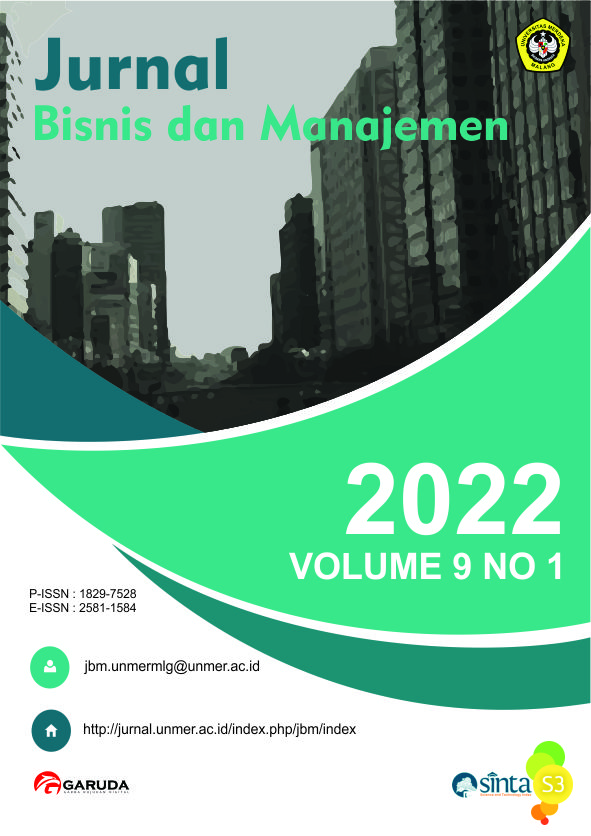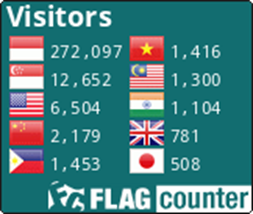The Effect of Green Intellectual Capital on SMEs’ Business Sustainability
DOI:
https://doi.org/10.26905/jbm.v9i1.7476Keywords:
green intellectual capital, business sustainability, SMEsAbstract
This study aims to examine the effect of the dimensions of green intellectual capital, i.e. green human capital, green structural capital, and green relational capital, on SMEs’ business sustainability. The data of this quantitative research was collected from a survey of 100 respondents and analyzed by using partial least squares. This study shows that green human capital and green structural capital have no significant effect on SMEs’ business sustainability and that green relational capital influences the sustainability of SMEs’ business. The findings enrich the abundance of knowledge concerning green intellectual capital, especially in the context of SMEs, and prove that green intellectual practices in the SMEs sector are still relatively low. They also imply that SMEs actors should pay more attention to the relational aspect as a relationship with stakeholders is the primary source of strength to win the competition.
Downloads
References
Akhtar, C., Ismail, K., Ndaliman, M., Hussain, J., & Haider, M. (2015). Can Intellectual Capital of SMEs Help in Their Sustainability Efforts. Journal of Management Research, 7, 82–97. https://doi.org/10.5296/jmr.v7i2
Bansal, P., & DesJardine, M. R. (2014). Business sustainability: It is about time. Strategic Organization, 12(1), 70–78. https://doi.org/10.1177/1476127013520265
Bicknell, S., & McManus, P. (2006). The Canary in the Coalmine: Australian Ski Resorts and their Response to Climate Change. Geographical Research, 44, 386–400. https://doi.org/10.1111/j.1745-5871.2006.00409.x
Bigliardi, B., & Galati, F. (2016). Which factors hinder the adoption of open innovation in SMEs? Technology Analysis & Strategic Management, 28(8), 869–885. https://doi.org/10.1080/09537325.2016.1180353
Bohdanowicz, P., Churie-Kallhauge, A., Martinac, I., & Rezachek, D. (2001). Energy-efficiency and conservation in hotels–towards sustainable tourism. 1–12.
Bontis, N. (1998). Intellectual capital: An exploratory study that develops measures and models. Management Decision, 36(2), 63–76. https://doi.org/10.1108/00251749810204142
Capello, R., & Faggian, A. (2005). Collective Learning and Relational Capital in Local Innovation Processes. Regional Studies, 39(1), 75–87. https://doi.org/10.1080/0034340052000320851
Chang, C., & Chen, Y. (2012). The determinants of green intellectual capital. Management Decision, 50(1), 74–94. https://doi.org/10.1108/00251741211194886
Chen, Y.-S. (2007). The Positive Effect of Green Intellectual Capital on Competitive Advantages of Firms. Journal of Business Ethics, 77(3), 271–286. https://doi.org/10.1007/s10551-006-9349-1
Daat, S. C. (2019). Pengaruh Pengungkapan Relational Capital Pada Kinerja Keuangan Perusahaan (Studi Empiris Pada Perusahaan High-Ic Intensive Industries Yang Terdaftar Di Bursa Efek Indonesia). Nominal: Barometer Riset Akuntansi dan Manajemen, 8(2), 255–273. https://doi.org/10.21831/nominal.v8i2.26702
Despeisse, M., Oates, M., & Ball, P. (2013). Sustainable manufacturing tactics and cross-functional factory modelling. Journal of Cleaner Production, 42, 31–41. https://doi.org/10.1016/j.jclepro.2012.11.008
Dickel, P., Hörisch, J., & Ritter, T. (2018). Networking for the environment: The impact of environmental orientation on start-ups’ networking frequency and network size. Journal of Cleaner Production, 179, 308–316. https://doi.org/10.1016/j.jclepro.2018.01.058
Edvinsson, L., & Malone, M. (1997). Intellectual Capital. Harper Business.
Erinos, N., & Yurniwati. (2018). Green Intellectual Capital and Financial Performance of Manufacturing Companies in Indonesia. Proceedings of the First Padang International Conference On Economics Education, Economics, Business and Management, Accounting and Entrepreneurship (PICEEBA 2018), 613–618. https://doi.org/10.2991/piceeba-18.2018.79
Firmansyah, A., & Hartanto, L. (2019). KAPITALISASI ASET TAK BERWUJUD YANG DIHASILKAN SECARA INTERNAL OLEH START UP COMPANY. INFO ARTHA, 3(1), 29–41. https://doi.org/10.31092/jia.v3i1.497
Gong, M., Simpson, A., Koh, L., & Tan, K. H. (2018). Inside out: The interrelationships of sustainable performance metrics and its effect on business decision making: Theory and practice. Resources, Conservation and Recycling, 128, 155–166. https://doi.org/10.1016/j.resconrec.2016.11.001
Hart, S. L. (1995). A Natural-Resource-Based View of the Firm. The Academy of Management Review, 20(4), 986–1014. JSTOR. https://doi.org/10.2307/258963
Healy, A., Malhotra, N., & Mo, C. H. (2015). Determining false-positives requires considering the totality of evidence. Proceedings of the National Academy of Sciences, 112(48), E6591. https://doi.org/10.1073/pnas.1518074112
Huang, C., & Kung, F. (2011). Environmental consciousness and intellectual capital management: Evidence from Taiwan’s manufacturing industry. Management Decision, 49(9), 1405–1425. https://doi.org/10.1108/00251741111173916
Johnson, W. (1999). Integrative taxonomy of intellectual capital: Measuring the stock and flow of intellectual capital components in the firm. International Journal of Technology Management - INT J TECHNOL MANAGE, 18(5), 562–575. https://doi.org/10.1504/IJTM.1999.002788
Jones, C., & Asensio, M. (2001). Experiences of assessment: Using phenomenography for evaluation. Journal of Computer Assisted Learning, 17(3), 314–321. https://doi.org/10.1046/j.0266-4909.2001.00186.x
Josephine, K., Ciptadi, B., & Aloysius, J. (2020). Pengaruh Green Intellectual Capital Terhadap Business Sustainability. Jurnal Manajemen Strategi Dan Aplikasi Bisnis, 3(2), 117–128.
Kamaluddin, A., & Kasim, N. (2013). The Relationship between Human Resource Management and Islamic Microfinance Providers’ Performance: The Mediating Role of Human Capital. International Journal of Business and Social Science 4(16), 52–57.
Karchegani, M. R., Sofian, S., & Amin, S. (2013). The Relationship between Intellectual Capital and Innovation. International Journal of Business and Management Studies, 2, 561–581.
Krejcie, R. V., & Morgan, D. W. (1970). Determining Sample Size for Research Activities. Educational and Psychological Measurement, 30(3), 607–610. https://doi.org/10.1177/001316447003000308
Kuo, L., Yu, H., & Chang, B.-G. (2015). The signals of green governance on mitigation of climate change – evidence from Chinese firms. International Journal of Climate Change Strategies and Management, 7, 154–171. https://doi.org/10.1108/IJCCSM-07-2013-0083
Linnenluecke, M. K., & Griffiths, A. (2010). Corporate sustainability and organizational culture. Journal of World Business, 45(4), 357–366. https://doi.org/10.1016/j.jwb.2009.08.006
Mehralian, G., Rasekh, H. R., Akhavan, P., & Ghatari, A. R. (2013). Prioritization of intellectual capital indicators in knowledge-based industries: Evidence from pharmaceutical industry. International Journal of Information Managemen, 33(1), 209–216. https://doi.org/10.1016/j.ijinfomgt.2012.10.002
Niesten, E., Jolink, A., Jabbour, A., Chappin, M., & Lozano, R. (2016). Sustainable collaboration: The impact of governance and institutions on sustainable performance. Journal of Cleaner Production, 155. https://doi.org/10.1016/j.jclepro.2016.12.085
Reed, K. K., Lubatkin, M., & Srinivasan, N. (2006). Proposing and Testing an Intellectual Capital-Based View of the Firm. Journal of Management Studies, 43(4), 867–893. https://doi.org/10.1111/j.1467-6486.2006.00614.x
Richbell, S., Szerb, L., & Kispál-Vitai, Z. (2010). HRM in the Hungarian SME sector. Employee Relations, 32, 262–280. https://doi.org/10.1108/01425451011038799
Santos-Rodrigues, H., Faria, J., Cranfield, D., & Morais, C. (2013). Intellectual Capital and Innovation: A Case Study of a Public Healthcare organisation in Europe. The Electronic Journal of Knowledge Management, 11(4), 361–372.
Sekaran, U., & Bougie, R. (2010). Research methods for business: A skill-building approach (5th ed.). John Wiley & Sons.
Subramaniam, M., & Youndt, M. (2005). The Influence of Intellectual Capital on the Types of Innovative Capabilities. Academy of Management Journal, 48, 450–463. https://doi.org/10.5465/AMJ.2005.17407911
Sudibyo, Y. A., & Sutanto, K. A. (2020). Environmental Consciousness and Corporate Social Responsibility as Drivers of Green Intellectual Capital. International Journal of Innovation, 13(4), 11.
Sugiyono, S. (2015). Metode Penelitian Kombinasi (Mix Methods). Alfabeta.
Tambunan, T. (2008). SME development, economic growth, and government intervention in a developing country: The Indonesian story. Journal of International Entrepreneurship, 6(4), 147–167. https://doi.org/10.1007/s10843-008-0025-7
Weerasiri, S., Zhengang, Z., & Dissanayake, R. (2012). Attitudes and Awareness towards Environmental Management and its Impact on Environmental Management Practices (EMPs) of SMEs in Sri Lanka. Journal of Social and Development Sciences, 3(1), 16–23. https://doi.org/10.22610/jsds.v3i1.681
World Commission on Environment and Development. (1987). Our common future. Oxford University Press; /z-wcorg/.
Yacob, P., & Moorthy, M. (2012). Green Practices: Perception of Malaysian SME Owners/Managers. International Journal of Academic Research in Economics and Management Sciences, 1(3), 103–111.
Yitmen, I. (2011). Intellectual Capital: A Competitive Asset for Driving Innovation In Engineering
Design Firms. Engineering Management Journal; EMJ, 23, 3–19. https://doi.org/10.1080/10429247.2011.11431891
Yong, J. Y., Yusliza, M.-Y., Ramayah, T., & Fawehinmi, O. (2019). Nexus between green intellectual capital and green human resource management. Journal of Cleaner Production, 215, 364–374. https://doi.org/10.1016/j.jclepro.2018.12.306
Yusoff, Y. M., Omar, M. K., Kamarul Zaman, M. D., & Samad, S. (2019). Do all elements of green intellectual capital contribute toward business sustainability? Evidence from the Malaysian context using the Partial Least Squares method. Journal of Cleaner Production, 234, 626–637. https://doi.org/10.1016/j.jclepro.2019.06.153
Downloads
Published
How to Cite
Issue
Section
License
Authors who publish with this journal agree to the following terms:
(1) Copyright of the published articles will be transferred to the journal as the publisher of the manuscripts. Therefore, the author confirms that the copyright has been managed by the journal.
(2) Publisher of Jurnal Bisnis dan Manajemen is University of Merdeka Malang.
(3) The copyright follows Creative Commons Attribution–ShareAlike License (CC BY SA): This license allows to Share — copy and redistribute the material in any medium or format, Adapt — remix, transform, and build upon the material, for any purpose, even commercially.














